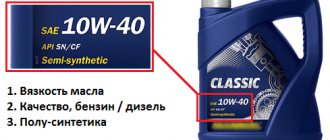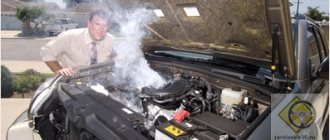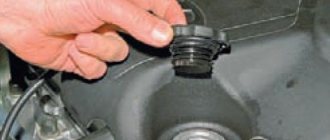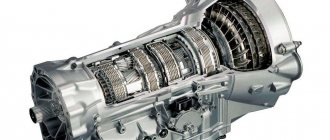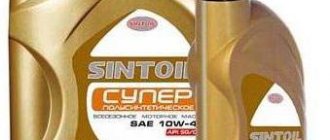Features of the problem
This problem can be divided into two types:
- increased consumption, at which the car smokes heavily;
- increased consumption at which the car does not smoke.
These are two completely different faults that are in no way related to each other. This article will bring some clarity to why the engine consumes oil. If with heavy smoke everything is more or less clear - it simply enters the combustion chamber and flies out into the exhaust pipe, then in the other version there is no such clarity.
But if you approach the question of why such a large flow rate appeared, logically, it will become clear that the reason for everything is an ordinary leak. This may explain why the engine began to consume a lot of motor oil.
It can leak in different ways, some places can be easily checked and traces can be found, and some cannot be easily found. What to do and how to detect oil leakage? It is enough to pay attention to the ground where the vehicle is parked, where an oil puddle will remain.
Places through which engine oil leaks are divided into two types:
- explicit;
- hidden.
Is it worth fixing the breakdowns yourself?
In any case, when there is unjustified consumption of engine oil, it is necessary to carry out diagnostics. However, self-diagnosis may not reveal the cause of the leak, especially if the motorist has been driving recently. Only a car service center can provide you with qualified assistance in this matter, so it’s worth going there.
It will be useful: Why does the automatic transmission not change gears and how can you solve the problem on your own?
An independent inspection can only roughly understand the cause of the malfunction.
- You can place paper or newspaper under the bottom of the car and look at the results when leaving the place. If red spots are detected, it can be assumed that there is a leak in the gearbox, but this only applies to cars with an automatic transmission.
- Yellow or brownish spots indicate problems with the engine or transmission in a car with a manual transmission.
If the engine has a distributor, oil can penetrate through the seal ring. Replacing the ring is not difficult. But with oil getting on the distributor, the situation is much more complicated. Such a breakdown can be easily identified by the characteristic cracking sound of the bearing and failures in the distributor itself. This requires disassembling, cleaning and replacing the entire assembly.
When you see that the oil is leaving too quickly, but the engine is not smoking, it means there is a leak somewhere. Sometimes the cause may be fluid squeezing out through the breather. Not everyone is able to detect such a leak by visual inspection; sometimes, to find out, it is necessary to disassemble the engine compartment and remove protective covers.
Explicit places
Finding obvious places is quite simple; to do this, you need to wash the crankcase of the power unit, drive the car onto a lift or inspection hole and visually inspect the oil traces. Let's look at the most likely leak locations.
Valve cover gasket
It has a fairly large area and loses its elasticity over time. Traces can be found without any problems, you just need to carefully examine it. It may well begin to leak through it. The malfunction is eliminated by replacing the old seal with a new one. After replacement, the engine will no longer consume a lot of oil.
Camshaft seals
They have increased wear due to the speed of the camshafts. Thus, they develop a sealing surface and lose the tightness of the connection. Characteristic marks are also revealed by careful inspection. Because of this, the engine eats a lot of lubricating fluid. The problem is solved by replacing old seals with new ones.
Front and rear crankshaft oil seals
They are also subject to increased load and lose their tightness over time. You can check them by simply inspecting the front and rear parts of the crankcase of the power unit, on which oil traces will be clearly visible. This may create the feeling that the car is eating a lot of lubricant. The malfunction is eliminated by replacing with new ones, but in order to change the rear oil seal, you will have to do a fairly large amount of work to remove the gearbox.
Engine oil pan gasket
It is one of the largest in terms of seal area and is subject to constant oil presence. Over time, it loses its sealing properties, which contributes to possible leakage. The problem is discovered by inspection. If you replace the gasket with a new one, the problem will disappear.
Front engine cover gasket
The part also loses its properties over time, and oil can leak through it. Here it’s worth looking more closely; often oil traces spread along the edges of the pan, and it seems that it is the pan that is leaking.
Filler cap
Through its rubber seal it can release lubricating fluid under pressure. The leak is fixed by installing a new filler cap.
Why does engine oil leak?
So, if the driver regularly monitors the lubrication level, then it will immediately be noticeable that the oil has left the engine. In this case, oil consumption is usually affected by two factors: engine oil leakage and oil burnout.
- Let's start with the most common reasons. For example, a breakdown of the cylinder block gasket occurs in the event of incorrect assembly of the engine and improper crimping of the cylinder head. The result is that the cylinder head is not evenly pressed against the cylinder block through the gasket, which leads to breakdowns in places where the cylinder head is loosened. The car owner can identify this malfunction with the naked eye by leaks of engine oil from under the cylinder head.
Also, a breakdown of the cylinder head gasket can also result in coolant entering the engine crankcase. In this case, this will be signaled by the appearance of an emulsion in the oil sump. When removing the oil dipstick from the engine crankcase, you can observe an increase in the oil level and an uncharacteristic whitish tint for oil (emulsion).
To solve the problem, it is better to deliver the vehicle by tow truck to the place of repair and replacement of the cylinder head gasket. It is also a mistake to believe that without replacing the gasket, additional tightening of the cylinder head will give results. The fact is that since the head gasket is already deformed, there will be oil leaks at the deformation sites.
A mandatory measure in this situation is to flush the lubricating lines from emulsion residues with flushing oil, after which the oil recommended by the engine manufacturer is poured into the engine.
For the information of car owners, motor oils of inexpensive brands, but with the appropriate viscosity coefficient, can be used as flushing oil. This will not cause any harm to the internal combustion engine, since the duration of operation of the engine on cheap oil is not significant, the loads are minimal, and the task of such a lubricant is to flush the engine from the emulsion. At the same time, savings on the car owner’s budget are obvious.
- Worn crankshaft oil seal (front or rear) is also a fairly common cause of engine oil leakage. This problem can sometimes be easily diagnosed by an oil puddle under the car or drips. However, in some cases, obvious leaks are not always visible without examining the lower part of the car.
Hidden places
Hidden places imply a leak that is not visible during simple inspection. To identify them, pay attention to other signs. Such options can confuse inexperienced car owners who are unable to understand why the engine eats a lot, does not smoke, and begins the wrong search for solutions. What needs to be done and how to check hidden places.
Cylinder head gasket
The main channel for lubrication of cylinder head parts passes through it. Breaking the gasket seal in this place will allow lubricant to enter the cooling system.
An inexperienced driver cannot detect such a malfunction. Not finding external traces of oil, he does not pay attention to the fact that the car eats a lot of motor lubricant and stops searching, thereby smoothly leading the power unit to failure and subsequent major repairs.
Crankcase ventilation
It plays a very important role in the correct operation of the motor.
When the ventilation is clogged, engine lubricant is released into the intake manifold or into the air filter housing.
This causes engine malfunction: characteristic uneven speed and loss of power. If there is an abundance of lubricant entering the intake manifold, it can interfere with attempts to start the engine. This malfunction cannot be detected by external inspection; to do this, you will have to remove the air filter cover, and only then will it be possible to understand the reasons why the power unit eats a lot of lubricant and does not smoke.
Coking of piston rings
It also promotes excessive consumption of lubricating fluid. The pollution enters the combustion chamber and begins to burn out little by little. At the same time, the engine begins to eat a lot of oil, emitting a subtle bluish smoke from the exhaust pipe, which often goes unnoticed. To eliminate the malfunction, the engine must be completely disassembled and the piston rings replaced.
Spark plug seals
Often, 16-valve powertrains allow lubricant to leak through the spark plug seals, which are located vertically in the valve cover. Lubricating fluid accumulates in the spark plug seats and is not visible during visual inspection. It gradually burns out from heated parts and leaves no traces.
The presence of a turbine in the power unit
It can contribute to increased consumption of engine lubricant through leaky connections. It will flow either outside or inside the intake manifold. This is also not visible to the naked eye, and if you don’t know, these traces will not be found.
Where does the engine oil go if the car doesn't smoke?
To answer this question, you need to study in detail all the places in the engine through which oil can leak. For this, a white sheet of paper is best suited, which should be left under the engine overnight. The next morning, by the location of the spots on the surface of the paper, you can determine the place where the leak is coming from.
If no stains are found on the sheet, you need to look for leaks in the most likely areas:
You need to carefully inspect the gasket under the valve cover. If there are clear oil streaks on the outer surface of the engine, then we can assume that the problem has been found. To solve the problem, you need to replace the gaskets under the valve covers or apply sealant.
Inspection of the pan gasket. This gasket may be worn. The solution to the problem is to replace the gasket. In this case, it is important to purchase a gasket that, according to the catalog, fully matches a specific car. It is not recommended to install gaskets from another car, especially one with signs of wear. Otherwise, the oil leak story may soon repeat itself.
Penetration of the pallet body when hitting a solid obstacle. In such a situation, you either need to replace the entire pan or, if the hole is not very large, you can try to weld it. You cannot use various cold welds to eliminate the leak. Indeed, under the influence of oil pressure, such temporary sealants do not provide a long-term effect and lead to repeated failure, during which a significant amount of oil is lost.
Oil seal failure. You need to immediately pay attention to the condition of the front oil seal mounted on the crankshaft. The seals located on the camshaft can also leak. It is very difficult to visually verify that the seal is leaking. It must be remembered that the main sign of oil leakage through the oil seal may be their strong fogging and excessive oiling of the place where they are attached. If the cause of the leak is in the oil seal, it needs to be changed as quickly as possible, since engine oil can get through worn oil seals onto other engine parts.
Lubricant may be leaking from the oil pressure sensor. In this case, you need to carefully tighten the sensor using a wrench. Perhaps the sensor is not screwed in correctly at all and has a technical defect. As for sensors, to avoid a similar situation, you need to purchase only original sensors and under no circumstances run for a low price. Otherwise, you can buy a Chinese fake of low quality and a bunch of future problems.
Oil may be leaking through an oil filter that has a defective housing or is simply not tightened tightly enough. In many cars, the oil filter is installed at the bottom of the pan and can be damaged if it hits a hard object. Sometimes, the thread in the filter may simply be torn off, which prevents it from being tightened tightly enough.
Allowable flow
You can say that a car consumes oil in excess of the norm if the consumption of the lubricant mixture does not correspond to the volume specified by the manufacturer. This parameter is determined by the engine size (depending on the number of pistons in the power unit). Table 1 illustrates the approximate oil consumption for waste with a working engine, taking into account the use of high-quality lubricant.
Table 1. The volume of motor fluid lost to waste after 8-10 thousand vehicle mileage*.
| Engine volume, l. | Amount of oil for waste, ml. |
| 1-1,6 | 150-200 |
| 1,8-2,5 | 180-250 |
| 2,5-3,5 | 200-300 |
*The table shows average values, see the operating instructions for your car for exact figures. For some models, the consumption rate will be several times higher.
Piston ring wear
Remove the dipstick that measures the oil level, start the engine and see if crankcase gases are released from the dipstick hole. If white or blue smoke comes out through the hole, then the engine mixture enters the cylinders, the gases enter the crankcase through the piston rings. If there is no characteristic blue smoke, check the compression in the cylinders.
When piston rings wear out, motor oil consumption can reach up to 1 liter per 1 thousand km. There are several types of piston ring wear:
- Abrasion of the outer side of the ring, which rubs against the cylinder walls. This leads to an increase in the gap between the cylinder and the ring.
- Reducing the thickness of the ring, it becomes thinner and moves freely along the piston groove. Reduced piston rings begin to throw the engine mixture towards the combustion chamber, increasing fluid flow. Such wear of the rings leads to very high oil consumption by the engine.
- The use of low-quality motor oil, leading to coking of the piston rings and a decrease in compression in all cylinders of the power unit.
Symptoms and characteristics of oil leaks
Checking the oil level
There are three main symptoms that can help you understand why your engine is burning oil. Firstly, there is a constant noticeable decrease in the proper level of lubrication, which is checked with a special oil dipstick. Secondly, the presence of dark puddles on the asphalt under the engine compartment of the vehicle after long and not so long periods of downtime. Thirdly, the presence of blue smoke in car exhaust. However, a situation is possible in which the engine eats oil but does not smoke.
It is a mistake to think that oil leaks are only typical for older cars. Of course, the largest percentage of problems occur precisely on those vehicles that have traveled more than one hundred thousand kilometers. Problems most often arise due to loss of wear resistance of parts subject to the greatest force overloads, or due to inappropriate vehicle maintenance. Untimely replacement of consumables or complete neglect of this procedure can cause a large loss of lubricant.
The likelihood of encountering excessive oil consumption on new cars increases when they fall into the hands of service technicians who do not have sufficient experience and proper qualifications in such matters. By the way, incorrectly selected viscosity of fuel and lubricants can also cause increased consumption. But let's talk about everything in order.
Deterioration of the valve stem seals, wear of the liners
Look at the operation of the power unit at idle speed. If the caps are worn out, the car eats a lot of oil. At the same time, but at idle it does not smoke or produces a small amount of smoke. If large clouds of blue smoke appear when you press the accelerator pedal hard, this indicates wear on the caps.
In most cases, excessive consumption of engine mixture through worn caps does not occur; less than 500 ml of oil per 1 thousand km must be added. If oil consumption increases, the piston rings need to be replaced.
The deterioration of the condition of the caps is also indicated by velvety carbon deposits on the spark plugs and interruptions in engine operation. Such phenomena occur if the cuffs of the valve stem seals harden or if they are significantly worn, and they do not provide the required seal and lead to free flow of oil under the guide bushing, along the valve stem.
If, while checking the oil level in the engine, you notice shiny small particles in the engine fluid, this indicates wear on the liners.
When is it time to be wary?
It is worth recognizing the fact that oil is not a fuel for which the exact consumption is established and determined. Thus, car models with older engines, by definition, consume more oil, but a modern car can do without oil at all, the consumption is so minimal. Of course, the age of the car is not the main criterion for panic. There are many other reasons when you can start to worry, of course, if all this is noticed in time.
The main reason that serves as the basis for a visit to a car service center is a significant and constantly continuing drop in the oil level in the engine, forcing the car owner to constantly add it, which indicates a leak. For timely and independent diagnosis of such a serious problem, it is necessary to constantly check the oil level in the engine - some experts recommend doing this before each car trip. It is easy to understand that in practice almost no one does this, so its leakage from the engine may not be detected immediately. The dangers of such inattention to your own engine are shown in the video:
Allowable natural waste of oil
Without exception, all modern car engines will have so-called natural oil waste. This is due to the peculiarities of engine operation, and for some models this figure is no more than 100 grams per 1000 kilometers, while other engines eat up 300-500 grams per 1000 kilometers traveled. It is simply not possible to solve such problems, and such loss of oil is allowed by the automaker and is not even recognized as a warranty case.
But if the engine begins to consume a liter of oil per 1000 kilometers, then the car owner needs to sound the alarm, initially perform an independent inspection of the engine, and subsequently take the car to a service center, carry out diagnostics and appropriate repairs. In each specific case, the malfunctions will be different; to solve certain problems, you will simply need to replace the leaky gasket, while for other machines you will need to change the valve group and perform an expensive overhaul.
We fix problems
Scheme for studying motor oil labels
If you notice that the engine is eating oil, and the reasons for this are wear of valve stem seals, rings, structural gaskets or abrasion of the walls of the cylinder block, then immediate replacement of these elements is required. Timely car maintenance will allow you not only to save money by preventing serious major repairs, but also to diagnose other possible problems with the engine system or the car as a whole in the early stages.
When selecting the right automotive lubricant, always rely on the manufacturer’s recommendations. Under no circumstances should you pour liquid under the hood whose viscosity prohibits the use of the car manual.
In addition, if you want to achieve economical fuel consumption, avoid sudden starts and braking. Of course, the instantly increasing power of the engine increases adrenaline in the driver’s blood, but in the car it causes overheating and active consumption of technical fluids. If you cannot give up extreme driving, then do not be surprised that oil consumption will be many times higher than the standards established by the manufacturer.
Why does the engine eat oil?
First of all, a car owner who is faced with the problem of rapid engine oil loss needs to pay attention to the condition of the valve cover. There are often problems with gaskets that wear out and do not hold high pressure, after which oil begins to leak through the engine. If the car owner does not pay attention to such faults, the engine is starved of oil, which ultimately leads to increased wear and the need to carry out complex and expensive repairs.
The engine may also lose oil along the camshaft and crankshaft seals. The presence of such smudges indicates serious wear. Such problems should be resolved as quickly as possible, which eliminates the occurrence of even more complex and expensive faults to repair. Unfortunately, such repairs will have a high cost; it is often necessary to change not only the oil seals, but also the camshaft itself, which significantly increases the car owner’s expenses.
The engine can also lose oil through the connection of the oil filter or pressure sensor. If the service technicians performed an oil change poorly and did not tighten the filter, then at high temperatures, oil under pressure can be driven through such problem areas, and in such a case it will simply be impossible to notice leaks under the car.
The engine eats engine oil, but does not smoke: what is the reason
If there really is no smoke, then the conclusion suggests itself - the lubricant does not burn out, but goes away. There are plenty of joints in the engine from which fluid under pressure can leak. This can be as small as a loose drain plug, or something more serious - for example, a sweaty valve cover. It is also possible that there is a leak, but there are no traces of it outside.
To make diagnosis easier, let’s divide all the symptoms into two groups:
- Clear leakage. When inspecting the engine compartment or area under the car, clear oily stains are found.
- Implicit leak. There are no external signs, it becomes noticeable only after dismantling a number of parts.
The leak location is clearly visible
The conclusion that there is a leak somewhere is usually made based on an inspection of a long-term parking area. Confirmation of this is oil traces under the engine. To make it more convincing, you can put a sheet of white cardboard. This will help determine the color of the liquid, and therefore find out which system has a problem. For example, a red or green spot indicates that the hydraulic booster (power steering) is leaking.
It will be useful: Changing the oil in the engine of a Kia Spectra car: step-by-step instructions and photos
Obvious leak points include the following connections:
- Cylinder head valve cover. To seal this joint, either rubber gaskets or sealant are used. The connection is quite capricious. For example, the cuff must be changed after each disassembly, and the sealant rarely lasts longer than 5 years.
- Cylinder block-sump. There is a rubber gasket installed here.
- Engine oil filter housing. A year earlier, we looked at why oil squeezes out from under the air filter on various engines. As a short summary, we present the following fact: oil can leak from this joint under the pretext of one of 7 reasons.
- Oil pressure sensor. Clamp the part and the leak will go away.
There are no traces of lubrication, but the oil is leaving
The situation is such that the engine compartment is clean, there are no stains under the car, and the dipstick clearly shows the sagging level of lubricant. The list of diagnostic actions in this situation is as follows:
- Look into the spark plug wells. For example, oil in the spark plug well of Lada Priora and Lada Granta with 16-valve engines leads to serious consequences. So, the ignition coil ends up in liquid and fails. This also threatens foreign cars, since there is no fundamental difference between “injectors” with 4 valves per cylinder.
- Remove the timing belt cover. Pay attention to the crankshaft and camshaft seals. Even a slightly sweaty rubber band needs to be changed.
For your information. A rubber-fabric timing belt is prone to rupture when exposed to oil.
Solutions to possible problems
The car owner, regardless of the reason for the loss of engine oil, should immediately contact specialized workshops as soon as such problems appear. In some cases, the nature of the malfunction can be determined by just a visual inspection of the motor, while in other cases it is necessary to open the engine, and such diagnostics will already have a high cost.
It is much worse if the cause of loss of engine oil is problems with the cylinder head. In such a case, it is necessary to bore the cover or completely change it, and the cost of such spare parts will be comparable to the cost of a major engine overhaul. Similar problems occur when the engine overheats and prolonged operation at elevated temperatures.
The car owner needs to remember that one should not skimp on diagnostics and quality of repairs. If the engine begins to lose oil, then such problems will not disappear on their own. The longer the car owner neglects such faults, the more expensive it will be to repair the car in the future.
Summarizing
As you can see, there are a fairly large number of answers to the question of where the engine oil goes if the car doesn’t smoke. But in order to find exactly the place through which the oil is leaking among all the probable causes, you need to conduct a thorough inspection of the engine. In this case, you can do some of the work yourself, and in some cases you need to contact service station specialists. After all, without certain equipment, oil removal may not be found.
You cannot put off solving this problem for a long time, gradually adding oil to the engine to the optimal level. After all, the car owner has no idea where the poured oil leaks and where it can cause a breakdown.
And all motorists are well aware of the cost of engine overhauls. In addition, we must not forget about vehicle safety, where any breakdown can lead to an accident.
Engine oil consumption is perhaps the most popular problem that worries drivers of both used and new cars. Even a new car can eat oil. Oil consumption can depend on driving style, ambient temperature and a bunch of other factors. I'll tell you what I know on this issue.
I want to start in chronological order, starting with a new car and ending with a used car.



